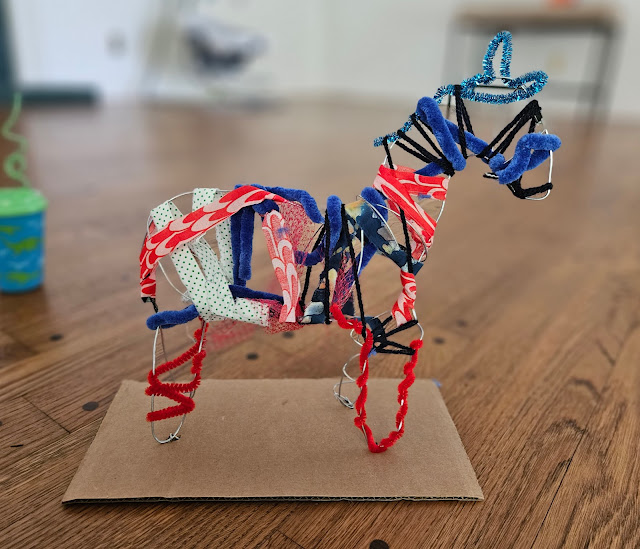Project #31 Deborah Butterfield Horse Sculptures
Deborah Butterfield is an American sculptor whose primary subject is horses. Many of her sculptures are life-size.
In the mid-1980s she began creating wooden armatures and having them cast in bronze. The bronze was then treated to resemble wood. Her use of bronze ensured her works a longer life, especially since many were exhibited outdoors.
Butterfield also uses found objects for some of her horses like the ones below.
A sculpture made with found objects and some of the found objects that Butterfield collects to use in her scluptures.
Butterfield and a larger than life sculpture made with found metal parts.
Some horses are made with natural materials like twigs, clay and other organic materials as well as small table top sculptures.
Making a miniature sculpture that is similar to Butterfield's horses requires a simple armature. An armature is structure that will act like the "bones" or your sculpture. Your armature can be pipe cleaners or wire or wooden chopsticks taped together. You can use cardboard, wood or plaster for a base.
We used 16 and 18 gauge wire and electrical tape from the dollar store to form these armatures.
The bases are made out of repurposed cardboard. We made 4 small holes in the base and attached the armature to the base with small pieces of wire that are twisted on the bottom to hold everything in place.
You can cover your armature entirely or you can leave part of it showing as part of your sculpture. See the student examples below.
Your horse can be standing, trotting or galloping. If you horse is jumping, you will need a base to help it stand up. Looking at photos of horses and understand their body movements is a great way to start this project.
Add found objects that you can wrap or tie to your sculpture: twips, moss, fabric scraps, piece of wire, pipe cleaners, bits of foam, pieces of plastic from drink cartons, paper scraps, string, raffia, etc....
Attach the objects to your armature by weaving them in, glueing, wiring and tyeing them.
You can paint the sculpture or parts of it or leave the materials as they are. The armature base will allow you to place your artwork on a table or shelf, it is good to have felt on the bottom of the base if it is made out of wood or plaster.
If you chose not to use a base, you may want to put small pieces of felt on the bottom of the horse's feet to keep from scratching surfaces.
To make your horse cover the wire armature (form, structure) with found materials: string, yarn, natural fibers, cloth…pretty much anything you want to that can be wound, woven, tied or glued onto the armature.
You can leave some wire showing or cover all of it up. If you want the horse to be more “fleshy”, put crumbled paper or tissue paper inside the structure and tape or wrap around it.
Have fun! Below are some student examples of horses and the materials that we used.

.jpg)












Comments
Post a Comment